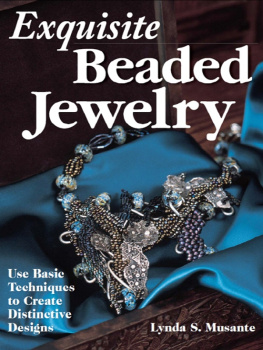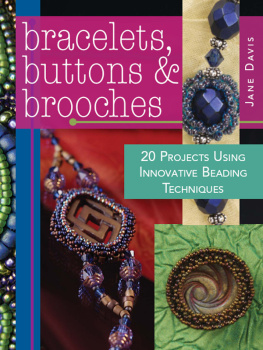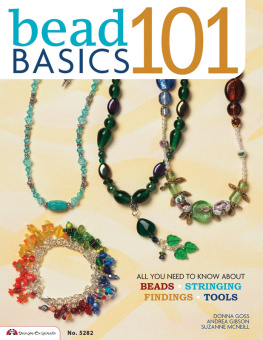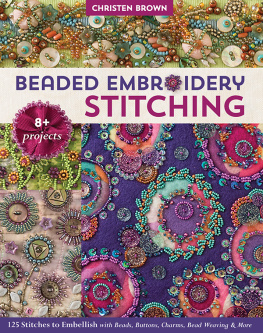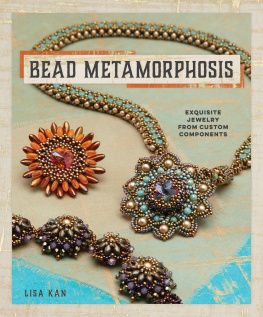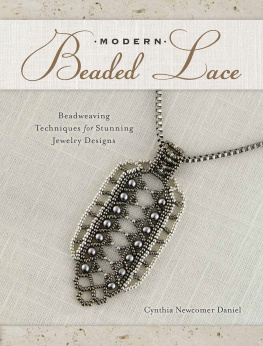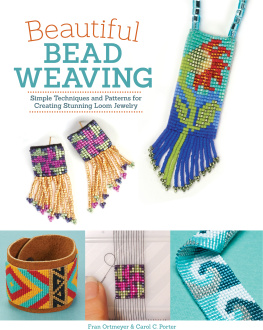M aking beautiful jewelry is a snap when you have the right tools at your fingertipsbeads, needles, thread, wire, scissors, cutters. But dont forget the most integral parta set of good instructions and clear illustrations such as those youve come to rely on from Beadwork magazine. With this kind of support youre sure to create a professional-looking project every time.

Dear Reader,
The components that make a piece of jewelry are few, really. Youve got beads, of course, and then the thread or wire to keep them together. Sounds elementary, my dear! But when you come right down to it, making a piece of jewelry can be daunting when you dont have the first idea how.
Does this describe you? Then Bead It with Beadwork will lead you on your way to becoming a skilled beadworker. Weve compiled sixteen classy projects that feature very detailed instructions and clear illustrations so you can teach yourself to work with beadsthe same kind of help you get from our magazine.
So enjoy yourself as you embark on the wonderful journey of beading, whether making a simple beaded necklace or taking on a bigger challenge. And always rememberbeadwork is fun!
Happy beading,

P. S. If youre not already a subscriber, Beadwork magazine offers all the latest bead buzz and plenty of new projects arriving at your door six times a year. You can subscribe online at www.interweave.com/bead or call (800) 340-7496.
Tying and adding new thread
Once your thread has 4" left, use the thread that lies between beads to anchor your working thread. Do so by tying an overhand knot with your working thread to the thread between beads. Pass through several more beads and tie another knot between beads. Pass through a few more beads to hide the last knot. Remove your needle and trim the thread close to the work.
Start a new thread in a similar way by tying knots between beads, always hiding the knot by passing through a few more beads and pulling tight.
Delica (or Antique or Delicious) beads are perfectly cylindrical modern Japanese glass beads with thin walls and large holes. They come in two sizes: regular approximates a size 12 seed bead and large is size 8.

Delica
Seed beads are very short pieces of chopped glass cane that are heated until they form smooth, almost round shapes. The most commonly available seed beads are Czech, ranging in size from 20, the smallest, to 7. Japanese seed beads are often more uniform than Czech and have larger holes.

Czech

Japanese
Contents
There are many devices manufactured today that can be used to bridge, connect, and finish beaded and wireworked jewelry. Here are some of them.
Lobster clasps, spring rings, and sister clasps can be attached to thread with knots or crimp beads. The clasps lock onto a jump ring attached at the other end of the thread.

Hook and eye clasps are just thatattach the hook to one end of a piece and the eye to the other end. Because the clasp works with gravity, it is good to use with pieces that have some weight (on lighter pieces, the hook and eye tend to travel apart).

Crimp beads and tubes secure loops of unknottable thread such as tigertail. Fold the end of the thread back on itself and slide the crimp bead/tube over and down the doubled thread until you reach a desired loop size. Secure the loop by squeezing the bead/tube tightly with a pliers to crimp it to the double-stranded thread. Trim excess thread.

Knot cups secure and cover knots at the end of a necklace or bracelet. They act as a transition between thread and metal findings. String the cup (domed side first) onto thread and tie several knots. Squeeze the domed sides over the knot, and bend the metal arm down to close cup.

French earwires or earclips are pierced-earring wire findings with an eye pin attachment for connecting an earring body. Bend the eye pin laterally with a pliers to open, slip on earring body, and bend back to close.

Jump rings are circles of wire used for connecting findings. To open, bend laterally (rather than make wider).

End cones cover the ends of beadworked chains, thin loomwork, or thick thread. They act as a transition between the chain body and finding assembly. String thread through end tip and connect finding assembly with knots or crimp beads.

Brooch backs have a pin assembly and a flat face onto which you can glue or sew a brooch body.

Head pins, used for stringing beads, are straight wires ending in a small perpendicular disk. The head of this pin acts as a stopper to hold the beads in place.

Eye pins are straight wires ending in a small loop. They are used for stringing beads.

.

Keriann Gore
This grand necklace is composed of some very special materialsdinosaur bone, carnelian, smoky quartz, and agate. If its hard to locate these beads, let the design of the necklace be your guide. Use the approximate bead measurements, colors, and textures to help you find similar beads to create your own special necklace.
MATERIALS
3' of sinew
1 large etched agate
4 medium cylinder etched agate
14 ostrich shell beads
4 round 4mm carnelian
2 round 8mm carnelian
8 round 6mm carnelian
40 black 4mm glass cubes
3 round 4mm smoky quartz
10 rectangular 4 6mm smoky quartz
12 medium fish vertebrae
6 cylinder 8mm fossilized dinosaur bone
240 small terra-cotta African pony beads (size 8 Japanese or Czech beads can be substituted)
2 sterling silver knot covers
Clear nail polish
Bali silver hook and eye
NOTIONS


